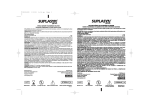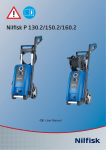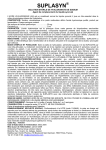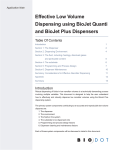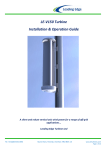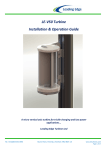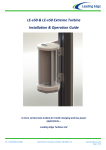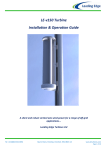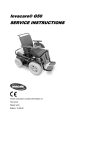Download Brochure for emailing
Transcript
Wind Turbine Service Platform Increase the lifetime of your high investment. The ISL Service Platform (ISL1) enables us to visually inspect blades and supply accurate still images of defects or damage, to industry recognised standards. At the same time we clean and polish the blades with Environmentally Friendly Products in a quick and perfectly safe manner. A planned maintenance schedule to include cleaning, polishing, scanning, blade testing and blade repair will help prolong the life of your blades. ISL Wind has been set up to offer a product that maintains wind turbine blades in a professional manner using the latest innovative technology and implementing the safest possible access methods. 1 2 4 3 6 7 5 1 2 3 4 5 6 7 Access Platform Controls Cleaning Brushes Brush Cowlings Camera Units Truck Boom Laser Sensors Motor Gearbox 8 9 10 11 12 13 Jetwash Spray Lance Left/Right Screw Motor Suction/Spray Pump Extendable Cage EX1 Controls Water Recycling Filtration System 14 Water Spray Bars 14 12 11 9 8 13 10 Analysis and Cleaning Keeping your blades clean, inspected and polished is a very sound investment. Increasing the frequency of analysis, cleaning, polishing and repair extends the lifespan and efficiency of the blades.The wind turbine service platform is attached to an access platform. The service and access platform combined provides everything needed to service a wind turbine blade in-situ, in one compact package. A water storage system, generator and water heating system are only part of the package; this illustrates the thought that has gone into providing a complete wind turbine blade servicing package. Once the access platform has lifted the wind turbine service platform into place the control of the cleaning equipment is set to automatic and an on-board computer takes care of the rest. The brush to blade pressure is closely monitored via laser sensors; this is so that the optimal brush pressure against the blade is applied. The sensors also make sure that the brushes follow every contour of the blade’s surface. The cleaning equipment’s water supply is set to a precise pressure so as to avoid blade damage and make sure that water is not wasted. The ISL1 typically recycles up to 60% of its onboard water supply. • No environmental damage from cleaning liquids. • No blade corrosion caused by high water pressure. • No blade damage caused by manual cleaning. • No long turbine shutdowns for cleaning and polishing. • No external power supply required. • No damage caused to any blade furniture. After Before Inspection and Reporting We can detect damage while we clean. During the inspection process the blade technician will monitor and inspect the blade’s surface, detecting any defects or visible damage. The still images are sent from the cameras mounted on the service platform to the onboard computer. All images are monitored during the analysing cycle. If a serious defect is identified by the platform’s technician, an image can be emailed immediately to the client using the touch screen monitor mounted on the service platform. All blades on the client’s wind park will have their own unique identification number, so that once archived they can be revisited to check and cross reference any future inspections/problems. The benefits of a pro-active approach using preventative and predictive maintenance tools and strategies Actual examples and case studies: Wind turbines are unmanned, remote power plants which, unlike conventional power stations are very much exposed to highly variable, harsh weather conditions, ranging from calm to severe winds and conditions ranging from tropical heat, lightning, arctic cold, hail and snow. In addition, because of these external variations, wind turbines undergo constantly changing loads, unlike conventional power plants. As a result of these highly variable operational conditions, there is high mechanical stress on wind turbines unmatched in any other form of power generation, and they therefore demand a high degree of maintenance to provide a safe, cost effective and reliable power output with acceptable equipment life. Maintenance approaches in all industries can be broadly classified into three major groups: Reactive Maintenance (run to failure) Preventive Maintenance (time-based) Predictive Maintenance (condition-based) The wind industry currently uses only Reactive Maintenance (fix it when it breaks) and Preventive Maintenance (following the wind turbine manufacturer’s service manual), and is not yet well versed in the newer forms of maintenance collectively known as Predictive Maintenance, which uses high tech condition monitoring technologies. Predictive Maintenance techniques and strategies are well known in more mature industries, such as in the energy (oil & gas) and utilities (coal and nuclear) sectors, as well as in the aircraft, military and major processing sectors, and the purpose of this paper is to demonstrate the benefits which the wind industry can expect from adopting these more modern predictive techniques and strategies to maintenance, (collectively known as “Pdm”) from these other, more mature industries. Sample Blade Inspection Report Inspection Report N° ISL/ Page 2 of 6 Inspection Report N° ISL/ Page 3 of 6 Blade Inspection Report Client Name: Address: Phone: Site location: Introduction: Damage Classification: Report prepared by: We have provided a full and thorough inspection of all Rotor Blades on the Turbine. Date: The evaluation is based on accepted rules in the field of Fibre Reinforced Components. The findings are classified into three Priority Damage Groups – Red / Orange / Yellow / Green, in order of priority / severity. Site location: The inspections were carried out by fully qualified and experienced Technicians. 1 – Red Site co-ords: - Horizontal Crack - Vertical Crack - Severe Damage due to Lightening - Strike Structural Stability - Decomposition of Laminate Turbine N°: Turbine type: Objectives: Date of manufacture: The key objective is to perform a precise and thorough external Inspection of the Rotor Blade, from the Hub to Tip, with a written report and supported with photographic evidence. Hub height: Inspection Start: Finish: PS - Pressure Side SS - Suction Side LE - Leading Edge TE - Training Edge LE SS This Inspection Report has been written conscientiously according to the best of the Authors knowledge as well as in accordance with the current state of technology. Blade Map Key Orange - Medium High Service delivered Inspection & repairs Yellow - Medium Low Findings and slight damage where action or repair is recommended. - Grease and Oil Pollution on the Blade - Gel Coat Chipping where the Laminate is not exposed - Pinholes and Resin Residue - Leading Edge Protection Tape Defects 5 – Blue Existing Fault. - Previously repaired fault, action may or may not be required Names and abbreviations of inspection codes as follows: Green - Low Priority l = Length Ø = Diameter ls = Lower Shell us = Upper Shell rc = Rear Chamber mb = Main Beam fc = Front Chamber le = Leading Edge te = Trailing Edge ss= Suction Side ps = Pressure Side Blue - Existing Repair Inspection Report N° ISL/ Page 4of 6 Main Data of the Inspected Wind Turbine Wind Farm: 4 – Green No liability will be assumed for direct or indirect damages, or for secondary damages resulting from undetected or partially detected flaws. Red - High Priority / Action Needed Damage which is not substantial, but requires effective repairs as soon as possible to prevent any further damage. - Decomposition down to Laminate - Cracks in Gel Coat at Trailing Edge - Vertical and Horizontal Cracks at Leading Edge - Heavy Erosion on Leading Edge - Surface Gel Crack - Gel Coat Chipping with exposed Laminate - Surface Paint Crack Disclaimer: Service ordered Inspection & repairs TE 3 – Yellow The Rotor Blades were examined at close range using High Level Access Inspection, Repair and Cleaning Equipment featuring the Revolutionary ISL Wind Service’s ISL1 Platform. On site personal: 123- TE PS Apart from identifying defects found, an important aspect is the identification of potential weak points in order to avoid subsequent damage occurring. Damage found with requires repair as soon as possible to prevent more serious damage. - Horizontal Crack Small - Crack Small - Severe Damage due to Lightening Strike - Structural Stability of the Rotor Tip is not ensured - Decomposition of Laminate started The Inspection Report describes the defects found during the Inspection and recommendations for further action supported by photographic evidence. Blade type / length: Blade Map Key 2 - Orange The objective of these inspections was to check the Turbine Rotor Blades for damage or defects and to evaluate any defects found. Blade ID: ABC- Substantial damage found requiring immediate repair or further detailed Inspection. Recommend no turbine operation before in-depth inspection and repair has been carried out. Inspection Report N° ISL/ Page 5 of 6 Inspection of the Exterior of Rotor Blade A Customer Inspection Report N° ISL/ Page 6 of 6 Blade Inspection Report – Blade A – (7) Wind Turbine N° SS PS Blade N°: Fault No. Priority Class Radius in Meter Damage Pictures B D A Leading Edge 1 2 0.5m 2m 3 16m 4 5 21m 22m 6 22.5m 7 23m 0.5m – 22.5m 9 10 11 2.5m & 3m 12.5m & 19m 0.5m to 12m 5m & 6.5m & 18m L/E 2x large Cracks (1) see annex L/E Small Crack (2) see annex Bad Seal on top of the L/E Protection Tape (3) see annex Damage to L/E Protection Tape (4) see annex Damage to L/E Protection Tape (5) see annex 22.5m to 23m missing L/E Protection Tape (6) see annex L/E Mat Erosion @ Tip (7) see annex Suction Side Extensive Intermittent Paint Cracks down virtually the length of the blade (- dashes on blade opposite) see annex 2 x T/E Gel Cracks 200mm + 650mm (9) see annex Gel Crack under Paint Crack (10) see annex Pressure Side Extensive Intermittent Paint Cracks (- dashes on blade opposite) see annex Gel Cracks under Paint Crack (11) Site Turbine Number/Blade Number Blade Serial Number Suction Side, Pressure Side, Trailing or Leading Edge Distance from Rotor Problem Length of Problem Distance from Leading Edge Inverin Wind Farm T3 - Blade - A 23 B17644 RCT L/E 23m L/E Mat Erosion 100mm N/A Blade Specialist’s Comments I suggest you get this problem dealt with as soon as you possible, if left, the L/E would eventually split open, become noisy and create more damage on the rotor. Fault Progression:




